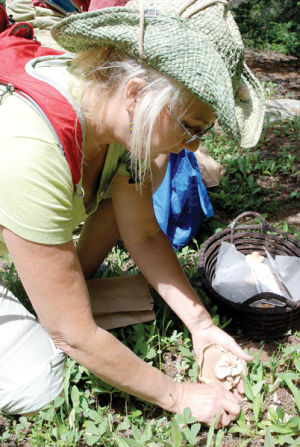
It’s the first day of the King Boletus Festival, and we’re driving along a rocky dirt road keeping an eye out for wild mushrooms when our Jeep grinds to a sudden halt before a grove of conifers.
Our driver – artist, town Planning and Zoning commissioner, former Army Ranger and mushroom hunter Tim Jaster – has spotted what we’re looking for: king boletus, a sought-after wild porcini that is the namesake of Buena Vista’s annual mushroom festival.
We jump out of the car and begin a careful search of the woods, stooping over the ground as if we were searching for a missing contact lens. The forest floor yields lactarius deliciosus, hawk’s wings and more of the delectable boletus, the three edible varieties that comprise the majority of our finds.
The area scoured, we emerge from the woods grinning, our baskets a little bit heavier with the weight of our newly foraged fungi.
“It’s almost as good as catching your first trout,” said Cooke Fisher, a newcomer to the world of wild mushrooms.
Over the ensuing hours, we scour the backcountry for more mushrooms, honing our identification skills with Jaster’s guidance.
“Some of the good places around here, you have to get off the road and hike awhile,” Jaster said.
The mushroom foray is a big part of Buena Vista Heritage’s annual King Boletus Festival, a two-day seminar featuring speakers from the Colorado Mycological Society. The event serves to demystify Colorado’s bountiful wild mushrooms, explaining their crucial role in the environment and aiding with identification.
“It’s pretty exciting to be able to find mushrooms that are safe,” festival participant Larry Friedrichs said.
It’s a worthwhile event for the budding mushroom enthusiast, as edible mushrooms look spookily similar to poisonous mushrooms to the untrained eye. Under Jaster’s watchful eye, we skip over what he calls LBMs – little brown mushrooms – and gravitate toward edible varieties with distinctive characteristics. By the end of the day, we’re able to distinguish between gills, tubes and spines.
We know to look for lactarius deliciosus’ hallmark orange hue, hollow stalk and green bruising. We have a better understanding of king boletus’ favorite habitat. And eating the mushrooms that we’ve foraged sounds like a mouthwatering idea, not a scary proposition.
Sue Sulley, who discovered a large boletus growing in a pile of rocks next to the road, described the experience as “awe-inspiring.”
Returning to our starting point at Turner Farm, we get a look at mushrooms foraged by the other 50-plus participants. One woman has returned with a blue-hued specimen identified by Colorado Mycological Society expert Ellen Jacobson as cortinarius violaceus.
A yellow coral fungus adorns the center of a picnic table. Another table is covered with a number of plump boletus harvested by Allen Mica, a Chicago resident who got his start mushroom hunting as a child in Transylvania, Romania.
“I used to go out with my grandpa and hunt porcini,” Mica said. “As soon as it’s daylight outside and you can see them, you pick them.”
The crowd is diverse, ranging from tattooed twenty-somethings to those well into their golden years. Those differences seem forgotten during the weekend festival, as thegroup unites over a shared love of mushrooms.
























